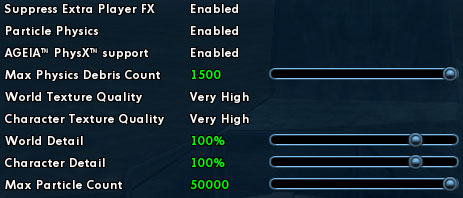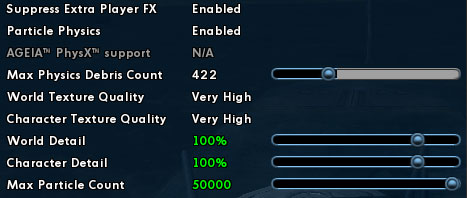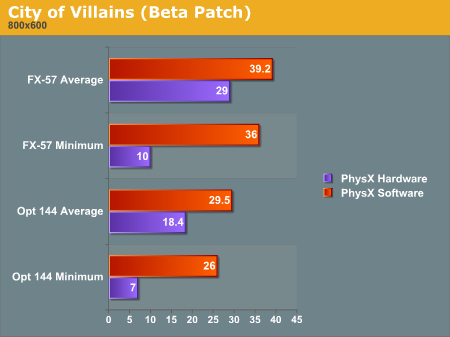City of Villains (Beta) Tests
Update: We would like to clarify that the beta version of City of Villains was stated as non-optimized in the release notes. The test server is open to any CoV subscriber and it does support PhysX hardware, but it is very possible for performance improvements to be made to the implimentation before their production release of the Issue 7 patch. In fact, we have been told by AGEIA that performance on the final code will absolutely be better than on the test server. We look forward to testing and reporting on PhysX support under production CoV code/servers as soon as possible.As with any MMOG, City of Villains has been difficult to test. The fact that PhysX hardware is only supported in a very specific area of gameplay makes it even more complicated. Luckily, we found a way around these issues. As City of Villains makes use of instanced areas for missions (multiple parties entering a single zone will each play the game in their own copy of that area), we were able to eliminate any outside influence from other players and go on a mission solo. Also key in our ability to test the Mayhem Missions (the part of City of Villains in which the PhysX hardware is used) is the fact that it is currently on the test server.
Normally, before a gamer gets a Mayhem Mission, he or she will have to do a bunch of other missions, level up a bunch of times, and unlock a contact called a "broker." The broker gives you access to "newspaper missions." After doing 3 of the newspaper missions, a broker will offer you a special job: a heist. In the future, and on the test server, this is where mayhem missions will be available. Each mayhem mission, once begun, has a 15 minute time limit. This limit can be extended by destroying things in the city, but there is no way to get enough time to actually benchmark multiple configurations of hardware. Doing 3 other newspaper missions and getting another mayhem mission isn't an option because this takes a huge amount of time (the missions can be different every time as well).
Fortunately, NCSoft offers the ability to copy your character to the test server at any time, multiple times. Our solution was to do enough missions to get to a point where we could be offered a mayhem mission (even though the missions are currently only on the test server). Then we copy our character over to the test server a bunch of times. Now we are able to accept the same mission any time we want.
This is great for testing a feature like PhysX, but doing a full test of the game is still hard. Working with a team fighting a huge number of enemies is a key element in the game. It's something that just can't be reliably repeated barring the assembly of an AnandTech guild built solely for choreographing, reenacting, and benchmarking scenes hundreds of times. For now, this is all we need. We included a screenshot of the game options with and without a PhysX card installed:


We created a couple videos to show the difference between hardware accelerated and software physics. Here are the numbers that resulted from our tests.


What we see clearly shows that the PhysX card is putting quite a strain on performance. Yes we get more mail or packing peanuts spewing forth from our rampant destruction. Yes, we do think it looks great with more stuff going on. But we are really not happy with the performance we are seeing here. It appears that our GPU is not overly loaded at these resolutions, as the difference between 800x600 and 1600x1200 gives very little in the way of performance gain without PhysX hardware installed. This implies that the bottleneck in performance is in the rest of the system. This is confirmed by the fact that performance drops considerably when running the test on a much slower CPU.
Whether on a low resolution with a fast CPU or a high resolution with a slow CPU, the PhysX hardware gives us low average framerates, very low minimum instantaneous framerates, and adds a bit of stutter to the movement of the game. Unlike the Ghost Recon test we showed last week, playing the game with the PhysX card feels much less satisfying. Multiple frames seem to take a long time to render (rather than just one or two) giving movement a choppy feel to it.
That being said, it is very important that we point out the fact that we are benchmarking code running on a test server. NCSoft makes it clear that code running on this server is not optimized and players may see degraded performance. We hope very sincerely that the performance issues will be resolved; right now it just isn't worth it.
So why include these numbers at all if it's on a test server? Well, the fact that they back up the results we saw in GRAW last week do lend some credibility the tests. What we seem to be seeing is that games which use the PhysX processor to tack on special effects physics take a performance hit when those effects are triggered. Of course, that only holds if the driver didn't fix the performance issues we saw in Ghost Recon.










67 Comments
View All Comments
phusg - Wednesday, May 17, 2006 - link
> Performance issues must not exist, as stuttering framerates have nothing to do with why people spend thousands of dollars on a gaming rig.What does this sentence mean? No, really. It seems to try to say more than just, "stuttering framerates on a multi-thousand dollar rig is ridiculous", or is that it?
nullpointerus - Wednesday, May 17, 2006 - link
I believe he means that the card can't survive in the market if it dramatically lowers framerates on even high end rigs.DerekWilson - Wednesday, May 17, 2006 - link
check plus ... sorry if my wording was a little cumbersome.QChronoD - Wednesday, May 17, 2006 - link
It seems to me like you guys forgot to set a baseline for the system with the PPU card installed. From the picture that you posted in the CoV test, the nuber of physics objects looks like it can be adjusted when the AGIEA support is enabled. You should have ran a benchmark with the card installed but keeping the level of physics the same. That would eliminate the loading on the GPU as a variable. Doing so would cause the GPU load to remain nearly the same with the only difference being to do the CPU and PPU taking time sending info back and forth.Brunnis - Wednesday, May 17, 2006 - link
I bet a game like GRAW actually would run faster if the same physics effects were run directly on the CPU instead of this "decelerator". You could add a lot of physics before the game would start running nearly as bad as with the PhysX card. What a great product...DigitalFreak - Wednesday, May 17, 2006 - link
I'm wondering the same thing."We still need hard and fast ways to properly compare the same physics algorithm running on a CPU, a GPU, and a PPU -- or at the very least, on a (dual/multi-core) CPU and PPU."
Maybe it's a requirement that the developers have to intentionally limit (via the sliders, etc.) how many "objects" can be generated without the PPU in order to keep people from finding out that a dual core CPU could provide the same effects more efficiently than their PPU.
nullpointerus - Wednesday, May 17, 2006 - link
Why would ASUS or BFG want to get mixed up in a performance scam?DerekWilson - Wednesday, May 17, 2006 - link
Or EPIC with UnrealEngine 3?Makes you wonder what we aren't seeing here doesn't it?
Visual - Wednesday, May 17, 2006 - link
so what you're showing in all the graphs is lower performance with the hardware than without it. WTF?yes i understand that testing without the hardware is only faster because it's running lower detail, but that's not clearly visible from a few glances over the article... and you do know how important the first impression really is.
now i just gotta ask, why can't you test both software and hardware with the same level of detail? that's what a real benchmark should show atleast. Can't you request some complete software emulation from AGEIA that can fool the game that the card is present, and turn on all the extra effects? If not from AGEIA, maybe from ATI or nVidia, who seem to have worked on such emulations that even use their GFX cards. In the worst case, if you can't get the software mode to have all the same effects, why not then atleast turn off those effects when testing the hardware implementation? In the city of villians for example, why is the software test ran with lower "Max Physics Debris Count"? (though I assume there are other effects that get automatically enabled with the hardware present and aren't configurable)
I just don't get the point of this article... if you're not able to compare apples to apples yet, then don't even bother with an article.
Griswold - Wednesday, May 17, 2006 - link
I think they clearly stated in the first article, that GRAW for example, doesnt allow higher debris settings in software mode.But even if it did, a $300 part that is supposed to be lightning fast and what not, should be at least as fast as ordinary software calculations - at higher debris count.
I really dont care much about apples and oranges here. The message seems to be clear, right now it isnt performing up to snuff for whatever reason.